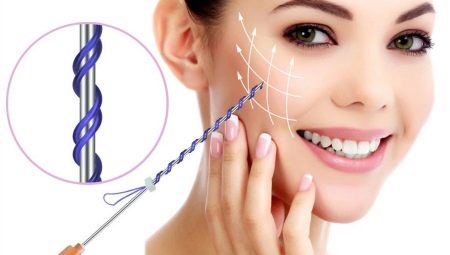Each representative of the beautiful half of humanity dreams of youth accompanying her as long as possible. But neither a healthy lifestyle, nor the selection of cosmetics, as well as proper care and even good hereditary genetics are not able to defeat time and aging. Signs that the skin began to age appear after 30 years, this is due to the fact that all processes in the body slow down. Modern plastic surgery and cosmetology can provide a wide range of youth support services. One of these procedures is thread lifting. This operation includes different types of work due to the materials used and the different duration of the result.
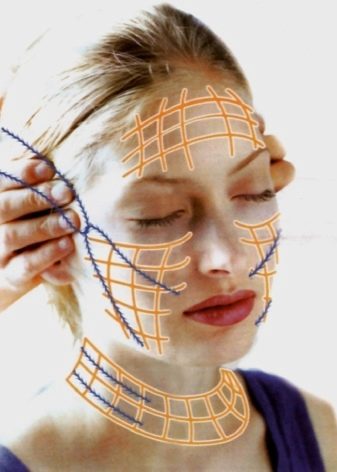
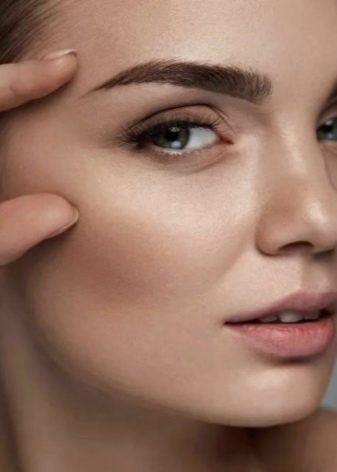
What is it and what is it for?
The procedure is necessary in order to make a kind of frame that will be under the skin and maintain its fit. The threads will act as a frame, they are made of special materials of a biocompatible type.
Such a procedure is done most often with the help of local anesthesia, the common one is used less often. The result obtained after the procedure is stored for several years. The result will depend on care, compliance with postoperative rules and the quality of the material.
The introduced threads allow you to activate the production of such an important element as collagen and to form scar tissue sections that are designed for muscle fixation. All this removes age-related changes on the face.
The first filament reinforcement was introduced by M. Sulemanidze into cosmetology, it was he who owned the patent for this unique technique.
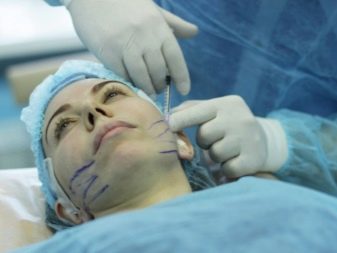
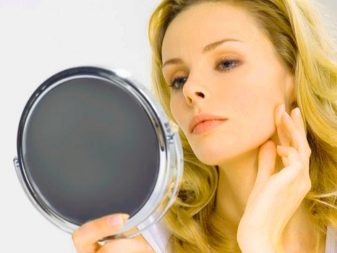
Kinds
All biomaterials that are intended for lifting are grouped into two categories: those that do not resolve, and those that resolve. The first remain under the skin in its original state, and the duration of the effect of them can reach 5 years. As for the second type, they affect the formation of collagen around itself and after that they begin to dissolve. The effect of using such threads is designed for only a few years.
However, these categories can be considered generalized, since in fact there are much more types, and each of them has its own positive and negative qualities.
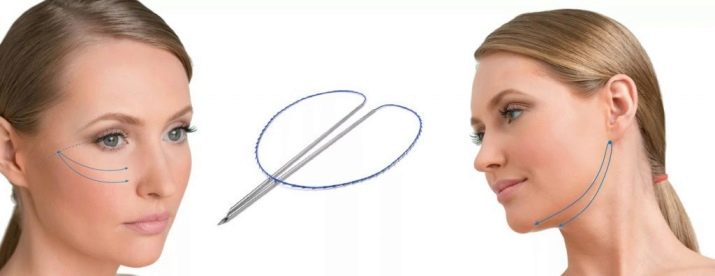
We should consider the following types of threads:
- non-absorbable type;
- combined;
- absorbable;
- mesothreads;
- liquid;
- smooth;
- conical;
- with notches;
- springs;
- spiral.
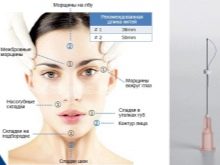
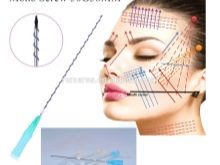
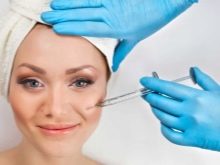
So, non-absorbable threads were presented in the form of a wire, which was made of platinum or gold. Preference was given to these materials for the reason that they were well perceived by the skin on the face, and after administration there was no allergy or rejection of the material.
Over time, their use began to find disadvantages, for example:
- it was impossible to carry out cosmetology services of a hardware type;
- when illuminated, the material could “shine through” through the skin;
- pigmentations formed.
However, despite these negative aspects and the fact that the material itself is very expensive, gold and platinum threads are used in lifting today, but the design has changed a bit. Today, other materials are used, these are threads with a thickness of not more than 0.1 mm. It contains a special base that dissolves after administration. Such a base is made of polymer.
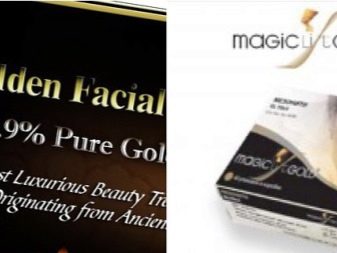
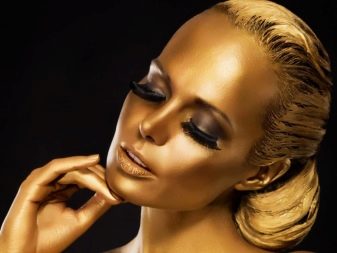
The material of the combined type is able to create a strong frame that will be flexible in any direction.
It should be noted that lifting using non-absorbable sutures is done in the deep muscle layer, for this reason the procedure can be painful. Due to the long-term effect, this operation is recommended for people over 50 years old.
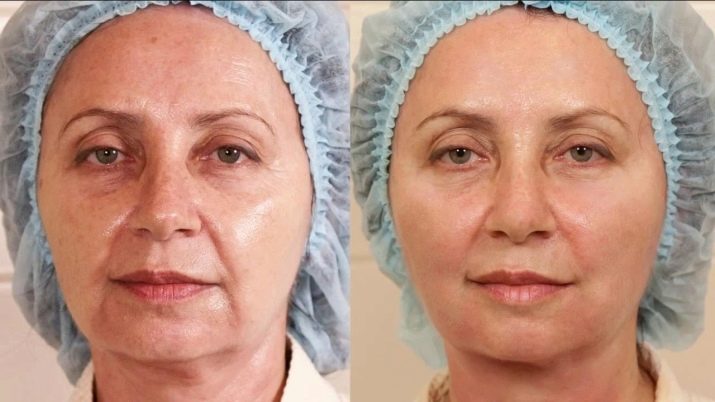
Lifting with a material of absorbable type is created due to the biodegradable component. The operation with this type of thread is done exclusively on the surface layers, so the result at the end will be invisible. The procedure is suitable for age categories from 40 years.
This type of operation is carried out due to modern materials that are made from caprolon or polypropylene. Lactic acid is necessarily included in the composition; it helps activate the metabolic process and rejuvenate the skin at the cellular level.
The process of resorption of threads lasts from 6 months to 1 year, it is during this period that a framework of pure collagen under the skin forms.
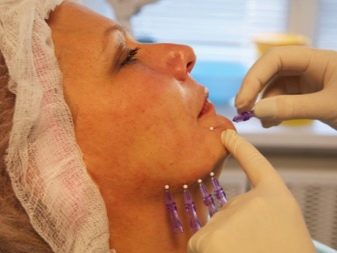
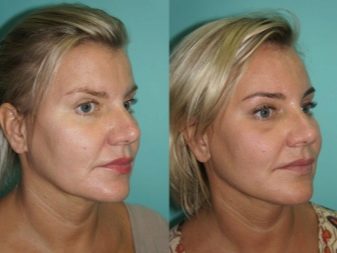
Separately, mesothreads should be considered, otherwise they are called surgical collagen monofilaments. They, like others, have their pros and cons. Filaments can be represented as bulk material. Mezzanines are currently the most popular. Korean beauticians developed this material. It itself includes a collagen rod, which is covered with a special surgical material (polydioxanone).
The mesothreads make it possible to simulate the carcass in different directions, therefore, as a result, you can get a natural skin texture. The dissolution of the collagen thread occurs after a maximum of six months, as for the rest of the coating, it is able to continue to fulfill its main function.
It should be noted that it was clients who began to choose mesothreads more often, since this material does not cause allergies, is not rejected by the body, and the result remains for 2 years. But it should also be added that one of the advantages of this material, when compared with other analogues, is its low cost.
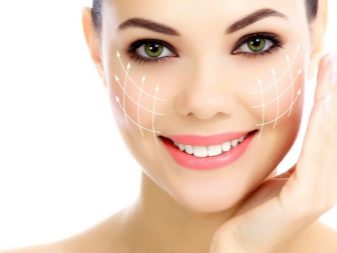
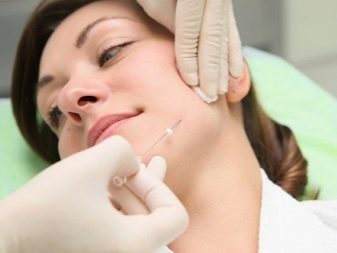
An alternative to the traditional type of lifting is bioplasty. This is the creation of the frame due to liquid threads. The process consists in introducing a gel-like composition under the skin of the face with a syringe and a thin needle. This composition gains hardness over time, due to this a very strong frame is obtained. The material allows you to maintain the effect for three years, in the future it is gradually eliminated from the body.

The texture of the material for anti-aging surgery has differences in surface type.
It can be smooth, conical options, with notches, springs and spirals.
- Smooth ones are used to tighten the forehead, cheekbones and chin area. Such threads are introduced through cuts of 5 mm length. Fixation of the material is done through special nodules that will be under the skin.
- Cone threads are an innovation; they appeared only 5 years ago. These are nodules that evenly distribute under the skin and create a secure fit. Many cosmetologists recommend this option.
- Threads that include a kind of "hooks". They are called notched models. For a certain part of the face, a different type of notch is used. The material is introduced inside through small holes to a depth of about 3 mm.
- Spring threads are used only on the most moving parts of the face, which include the cheeks and lips, since this particular material has increased elasticity.
- Spiral threads have a small length, their size is only 5 cm. The material takes its original shape after stretching. Most often, coils are prescribed in combination with other materials, especially if there is a need to do volumetric modeling at problem points on the patient's face, as well as with thin skin.
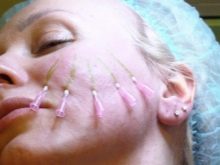
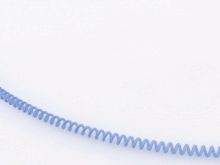

Indications
Such cosmetic therapy has been used for over 15 years. She is considered one of the most effective and at the same time safe. It is recommended that men and women after 35 years of age use this service. But this is only if other cosmetics have not yielded positive results.
What other indications exist for thread reinforcement:
- the appearance of wrinkles in the frontal area;
- the presence of wrinkles in the mouth;
- noticeable appearance of the second chin;
- lowering eyebrows;
- ptosis.
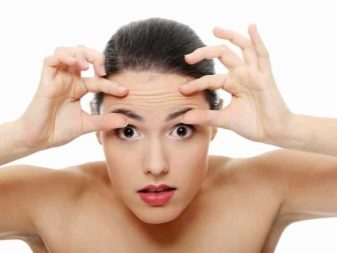
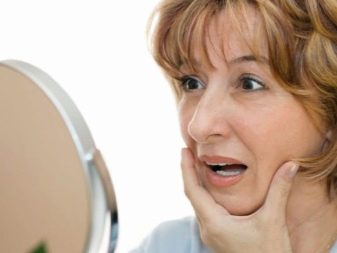
Contraindications
The first thing to say: after the operation is completed, you will have to adhere to the correct lifestyle, you will need to purchase exclusively high-quality cosmetics. You will have to eat right, you need to drink plenty of fluids, rest more often, avoid stressful situations, direct sunlight and other negative factors on your face. All this will help maintain a lasting result after surgery.
As for the contraindications of thread lifting, many aspects can be attributed to themfor example, the presence of diabetes mellitus, viral infections, inflammatory processes on tissues, cancer, asthma, problems associated with psychology, allergies to anesthetics. In addition, surgery is not recommended for those whose skin is too thick or, conversely, thin.


Technology
The threads used for lifting are attached under the skin in several ways:
- fixation is carried out along the ear, near the temple area;
- offline.
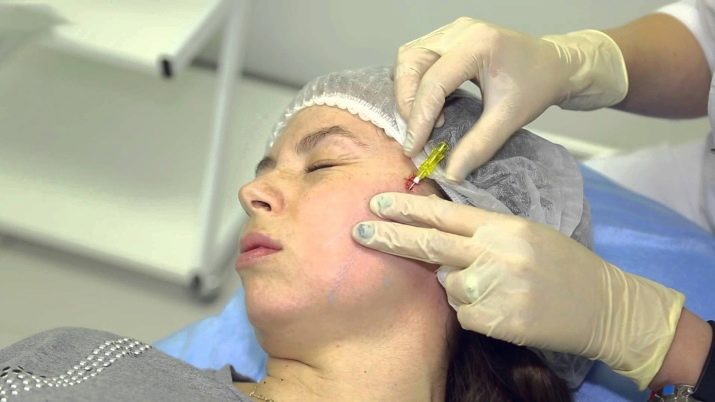
From the first process, the result will be pronounced. As for the second fastening, it is suitable only if the client needs to eliminate the changes associated with age. This type of procedure can only be performed in specialized medical institutions. We draw your attention to the fact that beauty salons do not engage in such operations.
Before lifting, a specialist in the field of cosmetology should examine the skin of the patient. He examines the condition of the skin, determines what changes are present in it, are there any contraindications.Based on all the information received, after examination, the specialist can determine which type of thread is best used in a particular situation in order to achieve the desired result. After all, the cost of the material and the operation is announced.
There are no special recommendations for preparation, very rarely, specialists can prescribe liposuction of the lower third, but this is only if the patient has excess body weight. After that proceed to modeling the trajectory of the threads. A project is created using computer technology and a specially designed program, after which the result is discussed with the client.
It is very important a few days before you go to the procedure, completely exclude from your diet strong alcoholic beverages, coffee, energy and drugs that thin the blood.

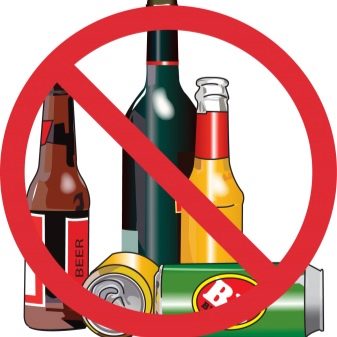
The whole operation involves several stages.
- Mark lines. These are the markups that specialists will be guided during the work when inserting threads.
- The use of anesthetic. Since the operation is painful, the patient may ask for general anesthesia. A general option can be used if a deep introduction of the material is prescribed when creating punctures or incisions.
- Modeling. In the process of modeling, the specialist distributes the introduced material, for this a needle or cannula is used. Each step is accompanied by reconciliation with markup.
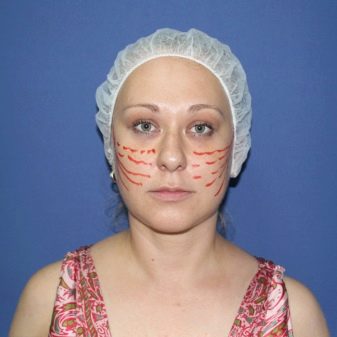
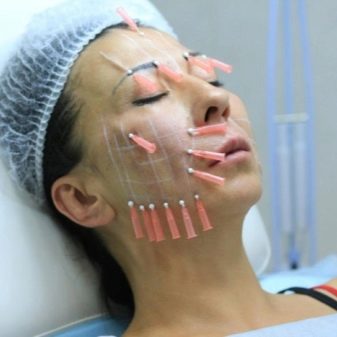
Work begins from the temple, after which the thread is moved to the chin area, then the material is removed from the back. For the operation, about 4 threads are used, if necessary, they can add a few more, place them at a distance of 2 millimeters from each other. The number and side of their direction may vary depending on the condition of the patient’s face. All this is determined individually.
The operation is completed by lightly pulling the material in the direction opposite to the needle. This allows you to fix everything in the tissues, especially this procedure is important when using notches.
In the event that a smooth variety of thread was used during the operation, a small fixing nodule is made at the injection site. After the procedure is completed, the places where the incisions were made or punctures were made are treated with a special antibacterial agent, after which the patient can be sent home.
The pricing policy of the cosmetic procedure will depend not only on the area of processing and material, but also on the reputation of a specialist and institution, so the price will be different in every institution. On average, the most budgetary procedure using mezzanines will cost up to 30 thousand rubles, and the most expensive procedure using platinum threads from 80 thousand.
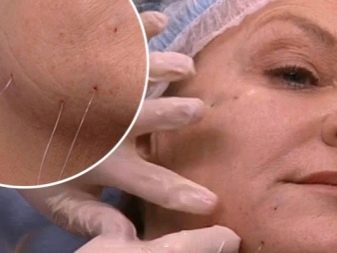
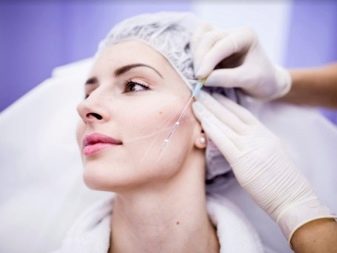
Rehabilitation
Many patients claim that after a procedure of this nature has been performed, movement discomfort appears. This can be explained by the fact that foreign material was introduced under the skin, but all the sensations are tolerable, and most often it takes several days to calm the pain.
It can take up to 6 weeks for a full recovery, the period will depend on how deeply the material has been introduced, as well as on the individual characteristics of the client’s skin and body.
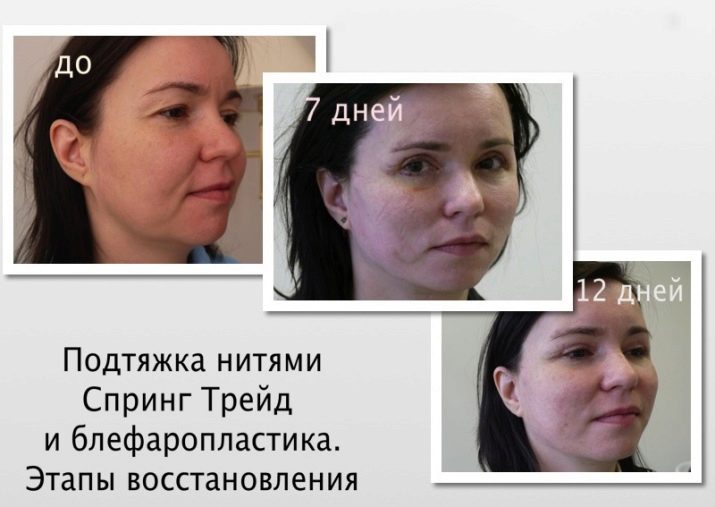
It should be noted that in the process of rehabilitation you must strictly adhere to specific rules.
Namely:
- try not to touch the face and avoid contact with water for 2-4 days;
- the first few weeks to do cool compresses, this will help eliminate puffiness and speed up the process of resorption of hematomas;
- for 1 month do not do massage procedures, do not sleep on the face;
- forget about hot drinks and food for a few weeks;
- it is very important to avoid direct sunlight on the face for at least 30 days;
- For several months, it is strictly forbidden to use scrubs, make any cosmetic masks, and also visit establishments where there is a fever, for example, saunas;
- it is advisable to avoid facial movements, until the moment when full healing begins;
- try to avoid exercise and stress.
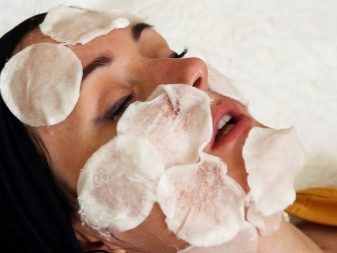
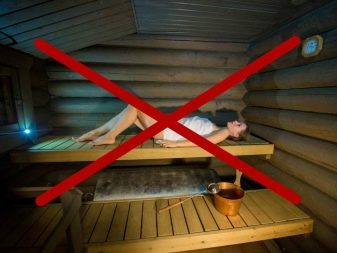
In addition, cosmetologists strongly recommend that you fix the face contour with an elastic bandage for the period of sleep.
All these restrictions are necessary in order to accelerate the fastening of threads under the skin. In addition, the result depends on compliance with these rules.
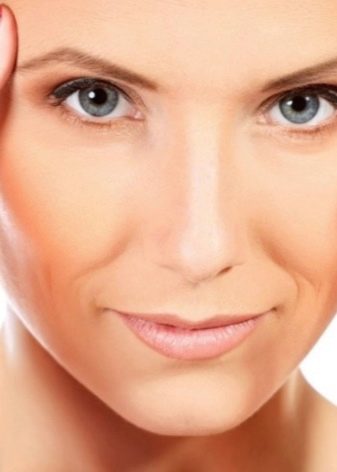
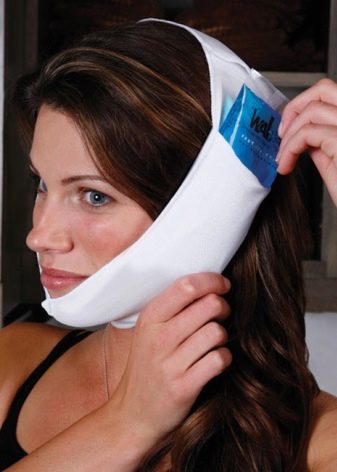
Do not forget that this procedure injures facial tissues.
Therefore, the first time you will observe:
- redness
- puffiness;
- hematomas.
As a rule, all this will pass in a few weeks. In the event that these consequences continue to persist longer, you need to contact the person who performed this procedure.
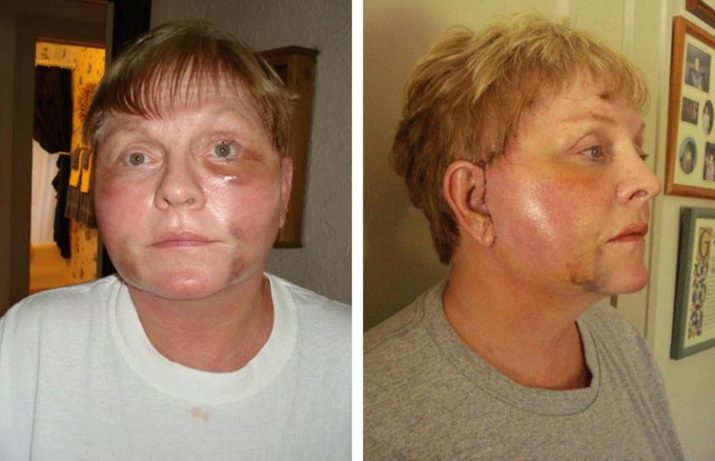
Complications after thread reinforcement can also occur if the patient turned to the master without qualifications, who did not comply with the correct technology and conditions for the operation.
Negative consequences may occur as follows:
- the appearance of asymmetry on the face;
- inflammations;
- the appearance of ulcers;
- puffiness, which does not go away for a long time;
- rupture of threads;
- necrosis of the skin;
- hematomas, which are becoming more extensive;
- pain of an intense nature that appears when touched.
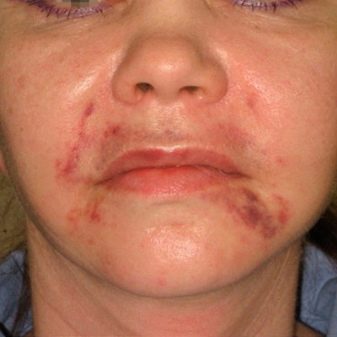

It is very difficult to fix such errors, and most often you have to delete threads. This procedure requires a long recovery period, in addition, the operation to remove the threads and correct the unwanted result is excessively complex. In order to avoid such consequences, you need to carefully select the institution, and discuss in detail with the specialist the upcoming procedure.
Reinforcing the face with the help of threads helps to restore the skin tone and shape, the skin becomes elastic, wrinkles are smoothed, and the water-salt balance returns to normal.
It should be noted that the result in the first days will be invisible, the first changes can be seen only after a few weeks, and the final image will be visible only after a few months.
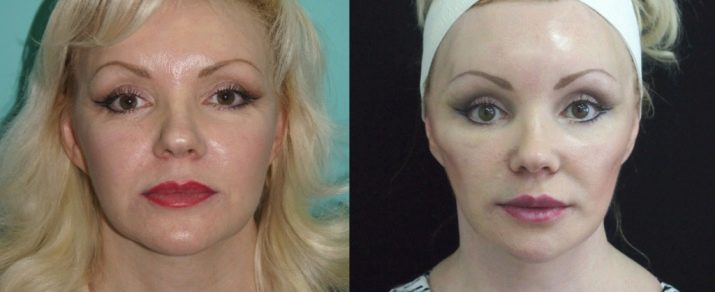
How long the effect will last depends on the age of the client and on the threads that were used during the operation.
- Mezoniti are recommended for clients aged 35 to 40 years, the validity of the result can reach 2 years.
- The effect of absorbable type threads lasts up to three years, they are recommended for patients under the age of 45 years.
- Non-absorbable varieties are able to maintain the skin in an elastic state up to 5 years, they are prescribed modeling for patients aged 45 years.
- As for the age after 50 years, many cosmetologists claim that this operation will be ineffective due to the fact that the body has practically stopped producing collagen. But, as practice shows, the implantation of non-absorbable or collagen threads can have a positive effect.
It is worth noting also that all the recommendations that were given above are conditional, and the result will depend on the condition of the tissues and whether the metabolic process is normal in the human body, because these indicators are different for each client.

Tips
Thread lifting can be called a very effective procedure, but it is better to use it only if the other methods of rejuvenation did not bring the proper result.
As already mentioned, the final effect will largely depend on whether the patient will comply with the established recommendations in the rehabilitation period. If this is not done, the threads can move and form a pronounced asymmetry on the face.
Today it is very difficult to choose the best materials, since they are absorbable, gold, medical, each of them has its own side effects and cosmetic consequences. The threads should be selected based on the age and zone of adjustment, since they are designed not only for the face, but also for the neck.
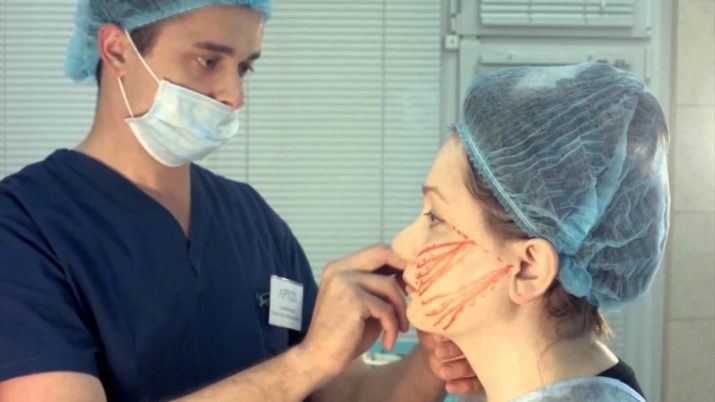
Immediately, we note that clients under 40 years of age are usually not prescribed a procedure with absorbable sutures. If you decide on this procedure after 50 years, then you need to decide which threads are best to choose.
If you look at patient reviews, then very often you can see the recommendations of the Aptos threads. These products are able not only to gain a foothold in the tissues better, but also to support the face contour.
For those whose age-related changes are clearly visible, specialists can recommend gold threads, since this material is harmless and hypoallergenic.
The threads that are used for facelift procedures are a great alternative to complex plastic surgeries. With this minimally invasive and safe procedure, you can get rid of wrinkles, a second chin, sagging skin, raise eyebrows and make your face a few years younger and more attractive.
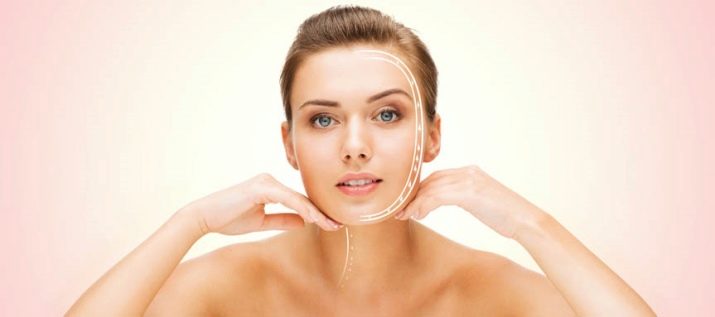
For a facelift using Aptos Exellence Visage threads, see the next video.
